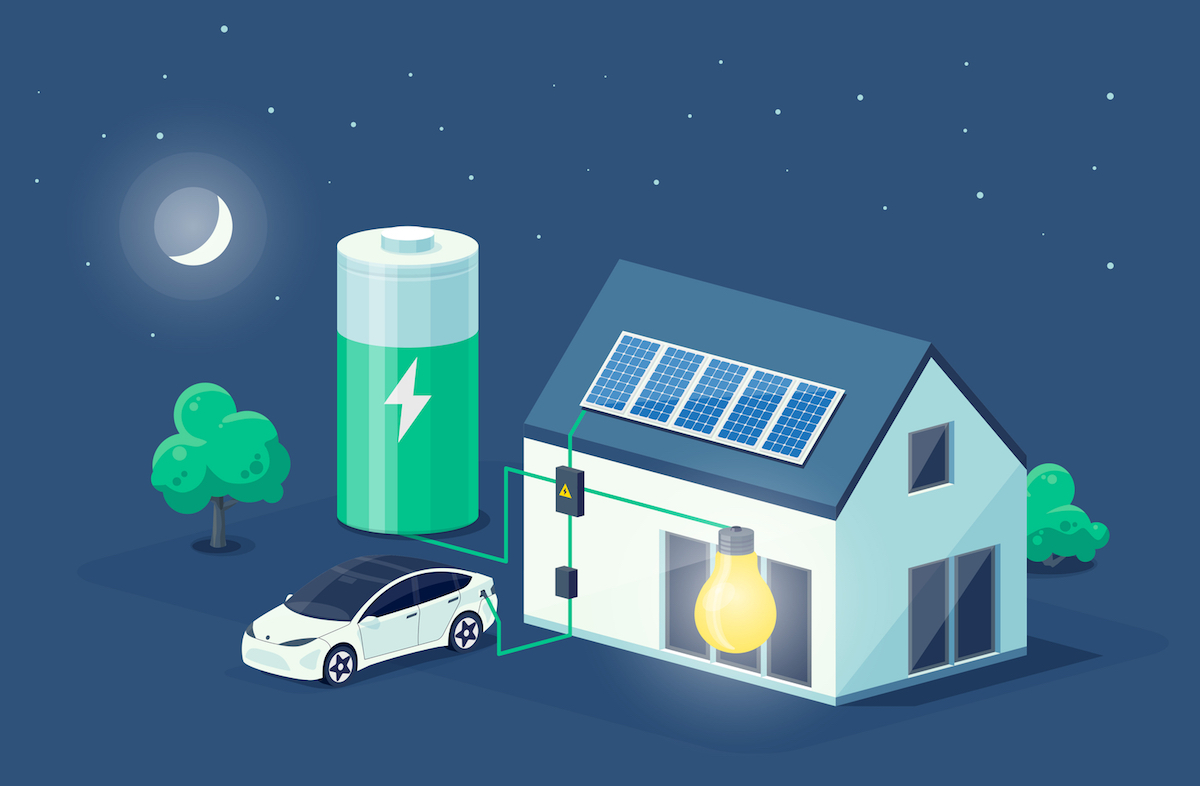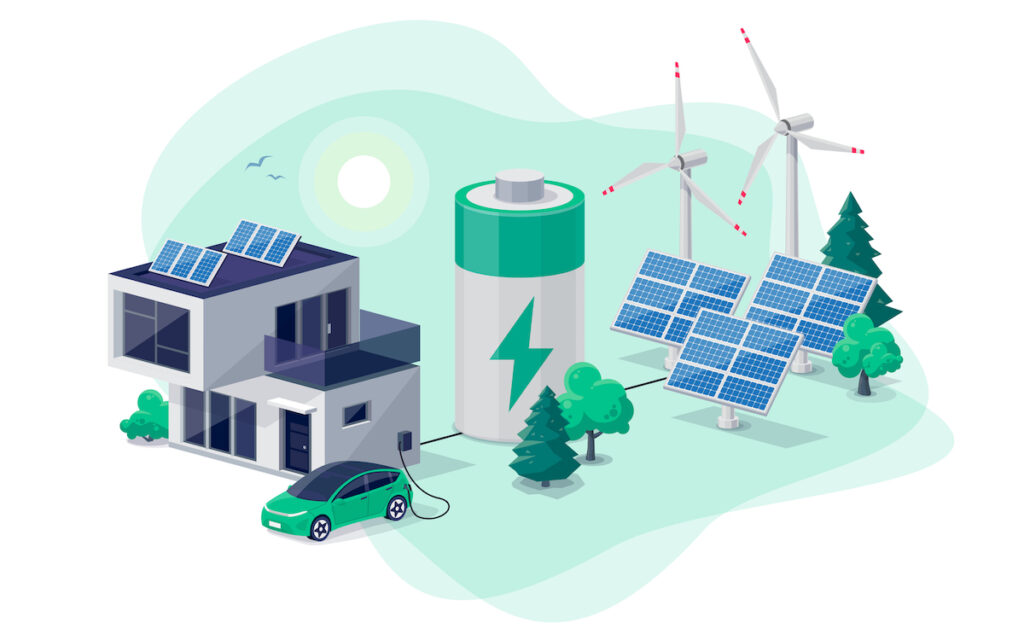 Image: petovarga – Depositphotos.
Image: petovarga – Depositphotos.Virtual batteries are a set of technologies and strategies that enable the virtual storage and management of energy, taking advantage of the flexibility of demand and the production of renewable energy.
In this article, we will explore how virtual batteries work and what their main benefits are for the energy transition.
Contents
What is a Virtual Battery
A virtual battery is a collection of technologies and strategies that enable energy to be stored and managed virtually, instead of using a physical battery. Virtual batteries have no physical form, but are made up of various components, such as demand side management systems, energy storage systems, and power grid control systems. These components work together to provide energy storage services to the power grid, leveraging demand flexibility and renewable energy generation.
Virtual batteries are often used to improve energy efficiency and reduce the cost of electricity, and can also be an important tool in the transition to a more sustainable and decentralized energy system.
How virtual drums work
Virtual batteries work by combining various components and technologies, such as demand management systems, energy storage systems, and power grid control systems. These components work together to provide energy storage services to the power grid, leveraging demand flexibility and renewable energy generation.

For example, demand management systems can use technologies such as smart thermostats or load switches to control the energy demand of buildings or industries. Energy storage systems, such as lithium-ion batteries or lead-acid batteries, can store renewable energy generated by sources such as solar panels or wind. And power grid control systems, such as charge and discharge control systems, can manage the distribution and flow of energy in the power grid.

When these components are combined, virtual batteries can provide energy storage services to the power grid, reduce energy demand during peak demand times, and improve overall energy efficiency. Additionally, virtual batteries can help integrate renewables more efficiently into the power grid and reduce reliance on fossil fuels.
Benefits of Virtual Farms
Virtual batteries have several advantages over physical batteries and other energy storage methods. Some of the major benefits of virtual farms include:
- Better efficiency: They can be more efficient than physical batteries because they don’t have the power losses associated with charging and discharging a physical battery.
- reduced costs: Can be cheaper than physical batteries, because they do not require the purchase, installation and maintenance of a physical battery.
- greater flexibility: They can be more flexible than physical batteries, as they are not limited by the size or capacity of a physical battery.
- longer life: They can have a longer useful life than physical batteries, because they are not subject to the same wear and degradation.
- More security: May be safer than physical batteries, as they do not have the risk of explosion or fire associated with some types of physical batteries.
- Greater resilience: They can be more resilient to natural disasters and other unforeseen events because they don’t have the vulnerability of a physical battery.
Disadvantages of Virtual Drums
Although virtual farms have many advantages, they also have some disadvantages. Some of the main disadvantages of virtual farms include:
- technological dependence: They depend on technology and software to function, which can cause problems in the event of failure or interruption.
- Need for a stable power grid– Require a stable electrical network to operate effectively, so they may be less effective in areas with old or unstable electrical installations.
- limited storage: Although virtual batteries are not limited by the size of a physical battery, they still have limits on how much energy they can store and distribute.
- Implementation costs: Although virtual farms can be cheaper than physical farms in the long run, the initial implementation can be expensive and require a large initial investment.
- Regulations and standards: May be subject to different regulations and standards than physical batteries, which may be a barrier to implementation.
Examples of successful virtual battery projects in different parts of the world.
Below are some examples of successful virtual battery projects from different parts of the world:
- California Virtual Battery Network: This project uses a network of virtual batteries across the state of California to improve energy efficiency and reduce the cost of electricity. The grid uses demand response systems and energy storage systems to provide energy storage services to the electric grid.
- Virtual Battery Project in Iceland: This project uses a network of virtual batteries to store renewable energy generated by hydro and geothermal sources in Iceland. The grid uses demand-side management systems and energy storage systems to provide energy storage services to the electric grid and improve energy efficiency.
- Virtual Drums in Japan: This project uses a network of virtual batteries in Japan to store renewable energy generated by solar and wind sources. The grid uses demand-side management systems and energy storage systems to provide energy storage services to the electric grid and improve energy efficiency.
- Virtual Battery Project in Australia: This project uses a network of virtual batteries in Australia to store renewable energy generated by solar and wind sources. The grid uses demand-side management systems and energy storage systems to provide energy storage services to the electric grid and improve energy efficiency.
These are just a few examples of successful virtual battery projects in different parts of the world. In general, virtual batteries are increasingly used around the world as a valuable tool to store and manage energy efficiently and sustainably.
How virtual batteries can help reduce the cost of energy for consumers and improve energy efficiency.
Virtual batteries can help reduce the cost of energy for consumers and improve energy efficiency in several ways:
- renewable energy storage: They can store renewable energy generated by sources such as solar panels or the wind, allowing them to make the most of renewable energy and reduce dependence on fossil fuels.
- Demand Management: Demand management systems used in virtual batteries can control the energy demand of buildings or industries, which can help reduce the cost of electricity.
- Flexibility: They are flexible and adapt to the needs of the electrical network, which makes it possible to make the most of energy and reduce costs.
- Better efficiency: They can be more efficient than physical batteries because they don’t have the power losses associated with charging and discharging a physical battery.
Challenges and obstacles in implementing virtual batteries and how to overcome them.
Although virtual farms have many advantages, they also face certain challenges and obstacles in their implementation. Some of these challenges and barriers include:
- Implementation costs: may require a significant initial investment, which may be a hindrance for certain projects.
- Regulations and standards: May be subject to different regulations and standards than physical batteries, which may be a barrier to implementation.
- technological dependence: They depend on technology and software to function, which can cause problems in the event of failure or interruption.
- Need for a stable power grid– Require a stable electrical network to operate effectively, so they may be less effective in areas with old or unstable electrical installations.
To overcome these challenges and obstacles, it is important to know the applicable rules and regulations, invest in high-quality and reliable technology and software, and ensure that you have a stable and well-maintained power grid. . Additionally, it may be worth collaborating with companies and organizations experienced in implementing virtual farms and seeking government funding and support to mitigate initial costs.
It is also important to note that implementing virtual farms can be a slow process, requiring time and effort to develop and optimize the right strategies and technologies. However, with the right time and investment, virtual batteries can be a valuable tool for improving energy efficiency and reducing the cost of electricity in the long run.


